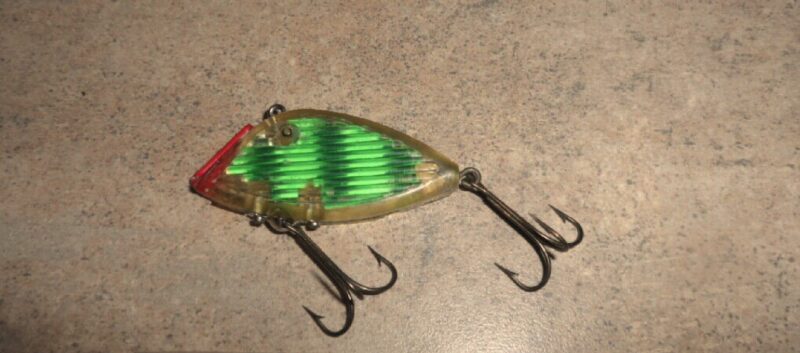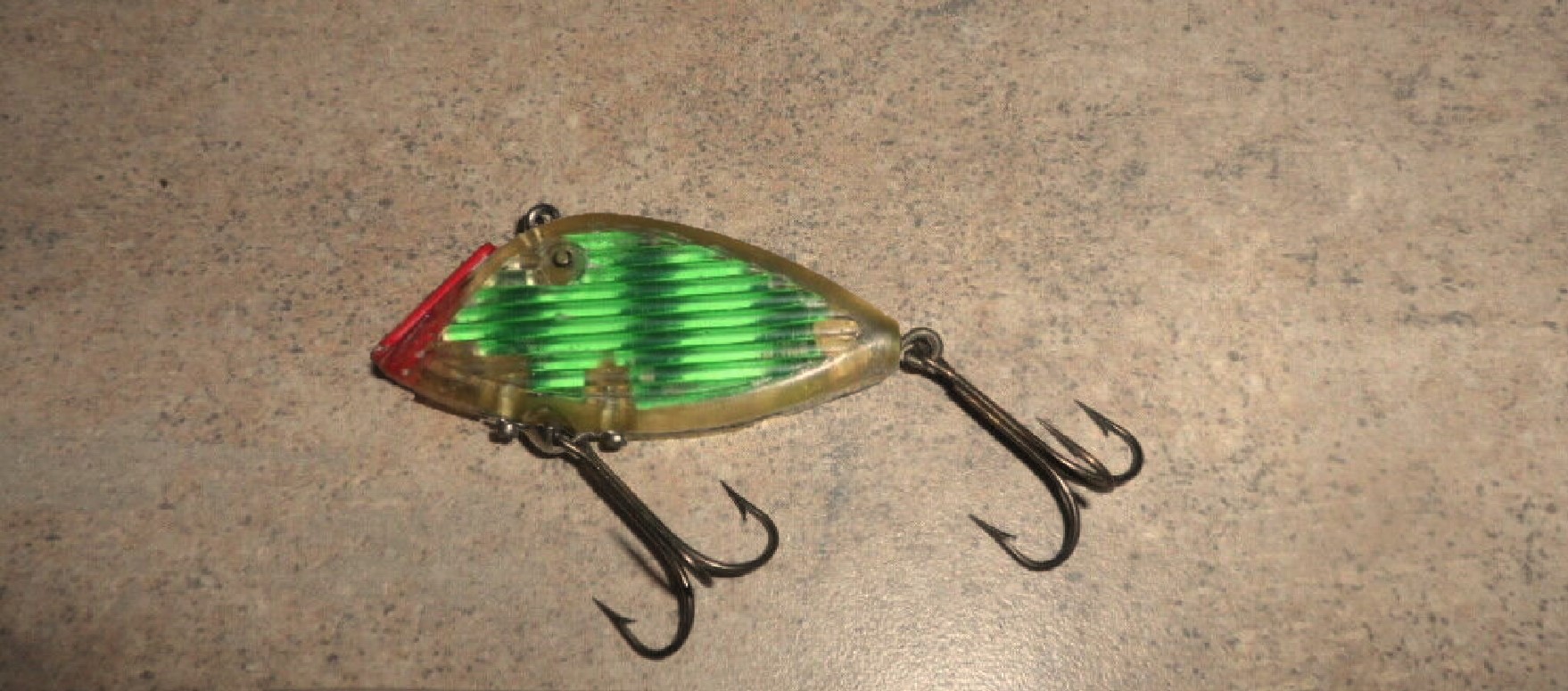
They sure don’t make them like they used to. My Dad used to have a special lure that he used constantly to catch walleye in my younger days. Actually, he called walleye “pickerel” as most Canadians did and still do, but today pretty much everyone knows them as walleye. The lure had a unique fish-catching and fishermen-catching gimmick. Today, there is no modern lure like it at your tackle store. Not one.
The lure was made in 1959 by the South Bend Tackle Company, although after reading their history that could even be debatable as to whether they made it or had another company make it for them. The history of this company is at https://historymuseumsb.org/south-bend-bait-company/
The company began in South Bend, Indiana as the Worden Bait Company in 1901 and its founder was Frank G. Worden. Jacob Kuntz had bought the company from Worden and in 1909, named it the South Bend Bait Company. Their most famous bait product line was the “Oreno” line as in Pike-Oreno or Bass-Oreno. In the ensuing years, ownership and management changes continued, but by late 1958, it was headquartered in Chicago, owned by Seymour and Benjamin Fohrman, and renamed once again to the South Bend Tackle Company. The name change was meant to reflect the fact they also made rods, reels and other accessories besides lures.
The lure my Dad had was named the “South Bend Optic” and it was so-named due to its design. It originally retailed for $1.35 and was probably the same price in Canada as it was in the United States. At that time the Canadian dollar was usually par or worth up to five cents more than the US dollar. He bought his Optic at Simpsons-Sears in Polo Park in Winnipeg in the 1960’s. At the time, my mother told him that the lure better be good at catching fish because it had already shown it was good at catching a fisherman.
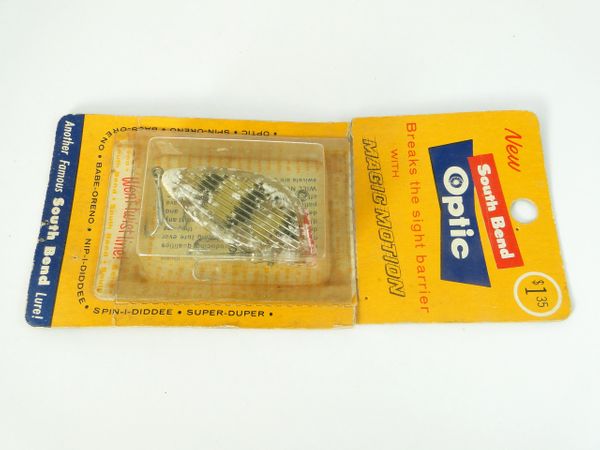
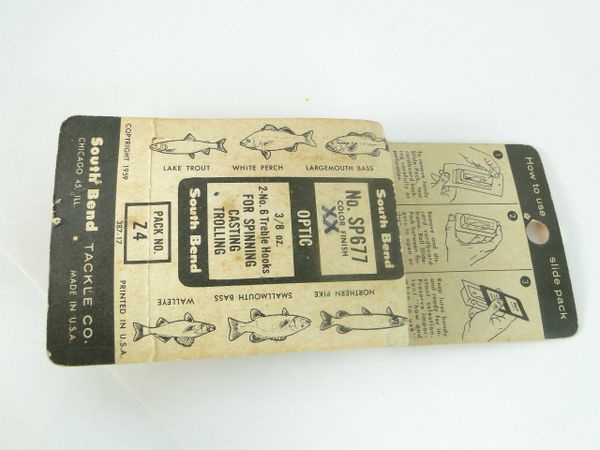
And it was easy to see why. The Optic was essentially a clear plastic shad-shaped minnow and sealed inside the clear plastic on both sides was another piece of plastic with 4 black vertical stripes on either a green, orange or yellow background. The outside plastic on the sides was edged or rippled to provide a prismatic effect. When you wiggled the lure, the black lines appeared to move forward and back on their own. It had a red plastic lip on the outside over its forehead. It had a raised eye on each side. Two size 6 treble hooks completed the lure. The packaging implied it could catch all kinds of fish.
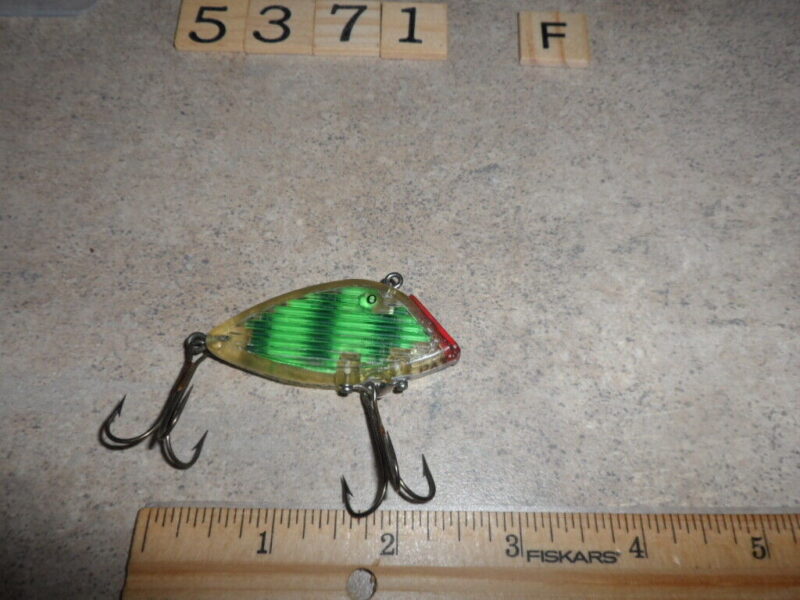
That lure always held a special spot in my Dad’s tackle box and it was, without question, his “go-to” lure. He used it when he fished in the lakes of Ontario and lakes and rivers of Manitoba.
On one memorable trip, he and I, along with a cousin and uncle of mine and led by my Dad’s cousin, Wilbert, fished a remote lake northeast of Kenora in a canoe, all five of us. The journey just to get to our destination was unforgettable and began at 4 a.m. at Wilbert’s home in Lac Lu.
I have spent many an hour trying in my later years to find that exact lake on the map or satellite photos but I cannot pinpoint it. I know it was quite a ways up along the Jones Road that runs roughly northeast from the Kenora Airport. As the sun came up, we finally got to the first lake we were to put in, we had to first load up the canoe (size large) with the five of us and our gear, and get in. Wilbert was going to be the sole paddler all day. We were at a public boat ramp on this remote lake with no lodges around and yet, there were 6 other boats there waiting to get in – from Iowa, Wisconsin and Michigan. We were in the middle of nowhere but these groups all knew this lake had fish apparently. The rest of us were there to fish and obey Wilbert’s instructions. Wilbert had chosen the lake we were heading to from information given to him by a local bush pilot. The pilot had spotted the smaller lake from the air just to the east of the one we were putting into first. He thought he had figured out a way to get to it via a portage through bush and muskeg. And, it “looked like it should have pickerel in it”. We set out on the first lake.
There were already other fishermen out on that lake and Wilbert did not want to let them see where we were going. He hated the fact even back then that American tourists were fishing without any regard for conservation so he was not about to share his discovery. Our instructions were to watch out for all of them and let him know when none were in sight. We went into a small bay on the eastern shore, were out of sight from everyone else on the lake, and that was when he made the mad dash to shore.
Our next instructions were to unload the canoe as fast as we could, and then follow him through the bush. When the canoe was empty, he strapped the two paddles across it, threw it over his shoulders and charged through the bush. No matter how hard we tried, we had a difficult time keeping him in sight. And each of us had a light load. Wilbert was a real authentic bush man.
After about half a mile through the bush, we arrived at a giant bog. It was the muskeg on the west side of the hidden small lake. Wilbert surveyed where he thought the best place to put in was hoping we might have a tiny channel to the lake. He studied it for a little bit, checked a few spots and chose our way in. Other than two or three shallow spots where we had to push our way through, we made it all the way through the muskeg to the west end of the small lake without getting too wet. And now, we had an entire lake to ourselves for the whole day. Almost.
I fished with a small red and white Dare Devil spoon and Dad put The Optic to work. While Wilbert paddled us up and back along the south shore, we all caught fish steadily. In no time we had our limit and only one pass up and back along the south shore was needed. When we got to the far east side of our mystery lake, we realized we indeed did have company on the lake after all. There in the weeds of a bay, stood a huge bull moose, grazing on whatever he could find. He kept his eyes on us but did not seem to be agitated at all. A little later, we had a shore lunch of sandwiches and a short break. Near the end of the trip, we pulled up to a nice flat rock and Wilbert cleaned and packed all the fish on it. We were on our way back out by late afternoon.
Dad eventually lost that lure on a log in another Ontario lake, but not until after it had provided him a lot of memories and a lot of “pickerel” on the stringer.
I acquired a couple of Optics off the internet for old time’s sake. Both are in the green color Dad once owned. I gave one to my Dad for his 100th birthday in 2021.
Check out the video here to see the prismatic effect of the South Bend Optic.
While building spinner rigs for Painted Back Rigs, I decided to pay homage to the South Bend Optic lure with a rig designed to reflect the color pattern without the prismatic effect. Our tribute in The Basics Group of product on paintedbackrigs.com is THE OPTIC NERVE with a Colorado size 4 sparkling bright green blade. (Sorry – SOLD OUT)

